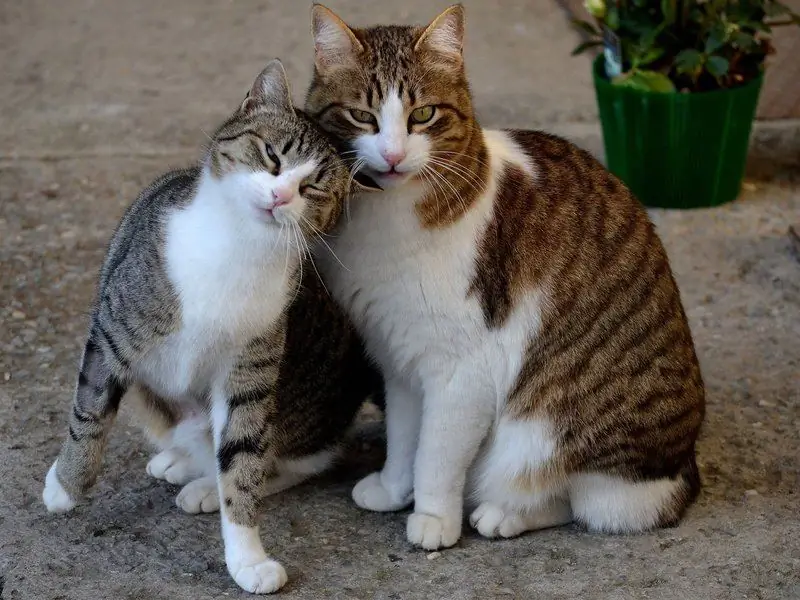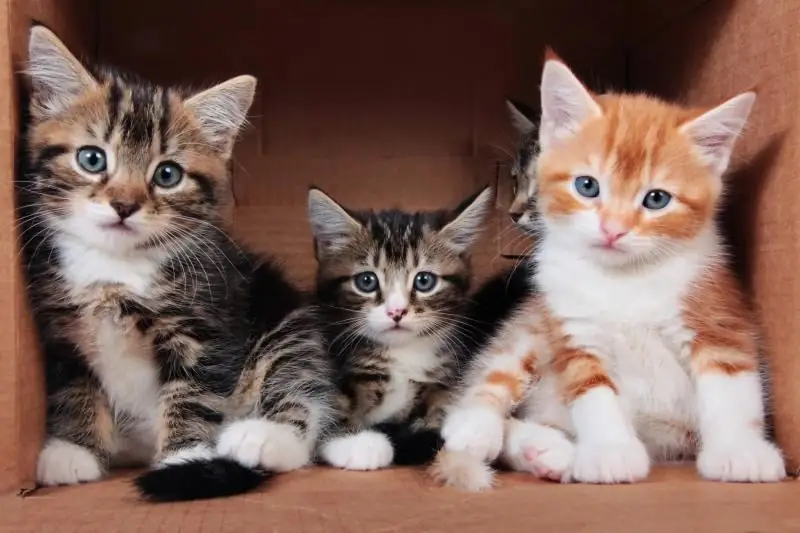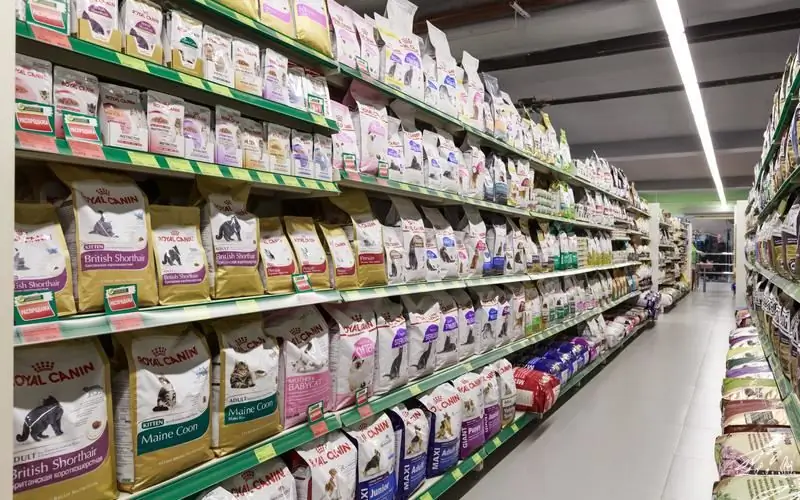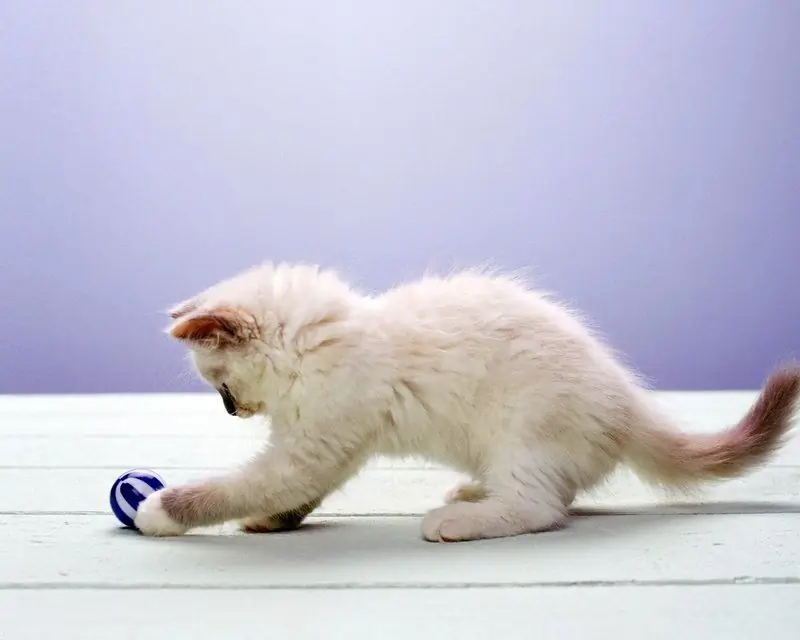
Table of contents:
- Author Bailey Albertson [email protected].
- Public 2023-12-17 12:53.
- Last modified 2025-06-01 07:32.
We consider how old the cat really is

Pet owners are often interested in the question of how to calculate how old a cat is in terms of a person's age. To find out the age of a four-legged family member, you need to figure out what are the ways that establish a connection between the years of life of a cat and a person. This will allow you to better understand your pet.
Content
-
1 Ways of the ratio of the ages of a person and a cat
-
1.1 Calculation by odds
1.1.1 Table: Age of Cats and Cats in Human Equivalent by Match Rates
-
1.2 The relationship between the ages of cats and humans
1.2.1 Table: Feline Human Age
-
1.3 Arithmetic calculation
1.3.1 Table: correspondence between the years of cats and humans
- 1.4 Other ways to determine a cat's age
- 1.5 Video: Human Age of Cats
-
-
2 Analogy of the age periods in the life of humans and cats
- 2.1 Infancy
- 2.2 Childhood
- 2.3 Youth
- 2.4 Early life
- 2.5 Maturity
-
2.6 Old age
2.6.1 Video: Caring for an Old Cat
-
3 How to extend the life of a pet
- 3.1 Balanced diet
- 3.2 Water regime
- 3.3 Other factors
Methods for the ratio of the ages of a person and a cat
Time passes more rapidly in animals than in humans. It is important to remember that all methods of converting feline years to human years are approximate, since it is difficult to compare the thinking of humans and the instincts of cats.
Calculation by odds
You can calculate the age of an animal in human years using coefficients. Their size shows the number of human years per year of the cat. Each of the age categories has special characteristics inherent only to it. The calculations are based on social and emotional differences existing at a certain stage of life.
Table: the ages of cats and cats in human terms by matching rates
| Cat age | Match Ratio | Human age |
| 1 month | 6-7 | 6-7 months |
| 2 months | 5-5.5 | 10-11 months |
| 3 months | 8-8.6 | 2-2.2 years |
| 4 months | 15-15.5 | 5-5.2 years |
| 5 months | 19.2-20.4 | 8-8.5 years |
| 6 months | 28-30 | 14-15 years old |
| Seven months | 25.7-26.5 | 15-15.5 years |
| 8 months | 24-24.75 | 16-16.5 |
| 1 year | 18-19 | 18-19 years old |
| 2 years | 12.5-13 | 25-26 years old |
| 3 years | 10-11 | 30-33 years old |
| 4 years | 8.75-9.25 | 35-37 years old |
| 5 years | 8-8.6 | 40-43 years old |
| 6 years | 7.1-7.6 | 43-46 years old |
| 7 years | 6.4- | 45-47 years old |
| 8 years | 6.25-6.63 | 50-53 years old |
| 9 years | 6.1-6.44 | 55-58 years old |
| 10 years | 6-6.3 | 60-63 years |
| 11 years | 5.6-5.9 | 62-65 years old |
| 12 years old | 5.4 | 65-68 years old |
| 13 years | 5.2-5.46 | 68-71 years |
| 14 years old | 5.1-5.2 | 72-73 years old |
| 15 years | 4.9-5 | 74-75 years old |
| 16 years | 4.75-4.8 | 76-77 years old |
| 17 years | 4.5-4.6 | 78-79 years old |
| 18 years | 4.4-4.7 | 80-85 years old |
| 20 years | five | 100 years |
Age ratio of cats and humans
Each year of an animal's life corresponds to several years of human life:
- The first year lived by a cat is equivalent to 15 years in humans.
- The second year will correspond to a person's 24 years.
- Then, 4 years are added to each subsequent year until the cat reaches 16 years old.
- After the cat overcomes the life milestone at 16 years old, 3 years are added to each lived year.
Table: Feline Human Age
| Cat | Man | Cat | Man |
| one | fifteen | eleven | 60 |
| 2 | 24 | 12 | 64 |
| 3 | 28 | 13 | 68 |
| 4 | 32 | 14 | 72 |
| five | 36 | fifteen | 76 |
| 6 | 40 | 16 | 80 |
| 7 | 44 | 17 | 83 |
| 8 | 48 | 18 | 86 |
| nine | 52 | 19 | 89 |
| ten | 56 | 20 | 92 |
This variant of calculations allows you to identify the following matches:
- In the first year of life, kittens learn to serve themselves, communicate with household members, and young people up to fifteen years of age develop similarly. During this period, both those and others are going through puberty.
-
From 2 years old, the cat has a mature character. The tailed beast knows how to ask the owners for something desired. The behavior of the animal at this stage of life is similar to the behavior of girls and young people at 24 years old.

Two year old cat A cat at two years old behaves like a young twenty-four year old man
Continuing to find common ground in the ages of a person and a cat, one can come to the conclusion that at the age of 15 years, corresponding to 76 years in the human dimension, the animal already has various diseases and changes in the behavior of animals, expressed in the following:
- interest in any kind of games disappears sharply;
- drowsiness appears;
- diseases associated with wear and tear of the animal's body occur.
Arithmetic calculation
It is very easy to determine the age of a cat by arithmetic. According to this method, the age of the cat is multiplied by 7. It should be understood that with this calculation, each year of the pet will correspond to seven human years. In this case, the result will not be the most correct.
Table: correspondence between the years of cats and humans
| Feline age, years | Person's age, years |
| one | 7 |
| 2 | 14 |
| 3 | 21 |
| 4 | 28 |
| five | 35 |
| 6 | 42 |
| 7 | 49 |
| 8 | 56 |
| nine | 63 |
| ten | 70 |
| eleven | 77 |
| 12 | 84 |
| 13 | 91 |
| 14 | 98 |
| fifteen | 105 |
| 16 | 112 |
| 17 | 119 |
| 18 | 126 |
| 19 | 133 |
| 20 | 140 |
The main disadvantage of this method is that it cannot be used to compare the age stages of a person and an animal
Other ways to determine a cat's age
Once you've picked up a street cat, its age can be difficult to know. You can determine how many years a cat has lived by visual inspection:
- on the eyes - in young cats they have a rich color, a bright iris, a clear pattern, and the eyes of an aging animal look dull, with a clouded lens, a dull iris, a disturbed pattern;
- in appearance - in youth, animals have a beautiful shiny coat, with age, the cat's coat becomes thinner, dimmer, with gray hairs; in addition, young animals are more clumsy, have prominent muscles, in adult cats and cats the torso is rounded, at this age animals are calmer and lazier than young ones, and older representatives of cats look thinner and their skin is flabby;
- by the teeth - if there is no information about the exact age of the cat, a veterinarian can determine how old the animal is approximately by assessing the general condition of the pet and the health of its teeth.
When it is not possible to visit a veterinarian and resolve this issue, you yourself should familiarize yourself with the process of tooth development in order to find out the age of the animal:
- Within the first month after birth, the kitten has milk teeth.
-
After 5-6 months, these teeth are replaced by permanent ones.

Kitten yawns Milk teeth begin to change to permanent at 5 months
- At a year and a half, the central incisors are erased in the cat's lower jaw.
- When the age of the animal reaches 2 years and 5 months, the incisors in the middle of the lower part of the teeth are erased.
- When a cat reaches 3 years and 5 months, the central upper incisors wear out.
- The middle incisors, located in the upper jaw of a cat, are subject to abrasion when the animal is 4 years and 5 months old.
- The age of five is accompanied by abrasion of the canines.
- In the upper jaw, before the onset of six years, the extreme incisors are erased.
- Changes occur with the rubbing surfaces of the middle and central incisors of the jaw below when the cat is 7-8 years old.
- Before nine years, the upper incisors in the center are erased.
- In the period from 10 to 12 years old, the animal's central incisors begin to fall out.
- Fifteen years of age can be accompanied by complete loss of incisors.
The aforementioned changes regarding the teeth can occur at other times. It depends on the lifestyle of the animal, in which the diet is of no small importance: the content of a large amount of vitamins and minerals in it slows down the process of abrasion and loss of teeth.
Video: the age of cats according to human criteria
An analogy between the age periods of humans and cats
Representatives of the feline breed can go through six main stages during their life from birth to old age. Cats, like humans, tend to behave differently at different ages.
If we make a comparison between a cat and a person, then we can draw the following conclusions:
-
in both cases, the infant is a helpless being, completely dependent on the mother;

Cat with kitten A newborn kitten is completely dependent on a mother cat
- in childhood, all kids learn about the world around them, acquire certain skills;
- in adolescence, a cat and a person are active, but have no experience;
- young people and cats are full of strength and energy;
- experience and skills come to them in adulthood;
- being old, they gradually lose activity, acuteness of feelings.
Infancy
The infant period in kittens is much faster than in humans, and lasts up to about 1 month. This time is the most difficult for the kitten: he learns the world around him, begins to walk.
The newly born kittens are completely helpless, they see and hear nothing. 5 days after birth, their eyes begin to open, and a week later, hearing appears. In the second week of life, milk teeth erupt. Translated into human age, this period corresponds to the age of 5-9 months.
At one month, kittens can run, jump, which corresponds to the age of children at 1 year and 5 months.

A kitten per month behaves like a one and a half year old child
Childhood
Childhood begins from the second month and lasts up to six months. During these months, the development of pets is very fast, and it is not easy to compare it with the corresponding years of a person. A three-month-old kitten in terms of intelligence is comparable to children of two years of age.
Inborn instincts help them in this, and they also learn from the example of their mother to take care of themselves. During the first year of its life, a cat overcomes all stages of growing up. By human standards, the end of childhood corresponds to 14 years.

A kitten's childhood ends at six months
It is during this period of time, when the kitten's childhood passes, that you need to pay attention to the issues of raising your pet in order to have time before the formation of undesirable skills and habits for the owner. For example, you should teach the animal that you can not scratch furniture or go to the toilet wherever he wants.
Youth
A cat's adolescence begins at 7 months and ends when he is one year old. Although the kitten is still growing at this time, its growth rate slows down. Cats enter puberty.

In adolescence, the cat begins puberty
In long-haired breeds, the coat reaches its constant length. The animal gets used to the environment, to the available pets, determines a distinct daily routine for itself.
In adolescence, adolescence, a cat should not be treated like a child, forgive her aggressiveness, petty dirty tricks such as left puddles. It won't go away by itself with age. Indeed, at this time, translated into human age, a cat becomes comparable to a teenager in a transitional age, and significant changes are observed in his behavior and character.
Youth
A cat's youth falls on the period from 2 to 6 years. At this stage of life, the cat feels strength in himself, he is tireless and agile.

The young cat is full of strength and agility
Youth (in humans it begins after 20 years) is the best time for a thoroughbred pet to be able to participate in all kinds of exhibitions and competitions. This period is also ideal for conceiving healthy offspring.
Maturity
For the period of maturity, the cat's age is from 7 to 10 years. For a person, these are years from 40 to 55.

Mature age occurs when the cat is over 7 years old
At this time, cats become calm, but sometimes they can play. Professional breeders of pedigree animals that have reached adulthood cease to breed them.
Old age
Cats over 11 years old, sometimes living up to 20 years or more, are considered elderly. The venerable age of the animal does not at all speak of its imminent death. The longevity of a cat depends on its health and living conditions.

An elderly cat becomes after 11 years
Pets, for example, often overcome the bar in life at 16, and street cats live no longer than 10 years. With good care, cats feel great in old age.
Domestic pet - cat Kuzya from the Persian breed delighted those around him with his presence for 14 years and lived to old age. Throughout his life, he was always active and inquisitive.
Video: caring for an old cat
How to extend the life of a pet
Any owner of a cat or cat wants a long life for their pet, but a number of factors affect its duration.
Balanced diet
A balanced diet will help to prolong the pet's life. It significantly affects the health of the cat, increases its activity. The animal's coat becomes smooth, the stool becomes regular. When calculating the composition and nutritional norms, the age and breed of the cat, the state of its health, the physiological characteristics of the organism, and the feeding regime should be taken into account. Excess or lack of nutrients leads to the appearance of diseases such as kidney failure, colitis, obesity, allergies, diabetes and others.
Proper nutrition means that the animal consumes and expends the same amount of calories. Energy is consumed by the feline body constantly (and at rest), and is replenished with the help of nutrients from food. The feeding ration should be filled with a certain amount of proteins, fats, carbohydrates, minerals, vitamins, water. Therefore, young and active cats require more frequent meals and high-calorie foods. High-calorie foods are also needed by pregnant and lactating cats with increased energy expenditure. Older cats have lower energy costs, they eat less.

Pregnant and lactating cats need more nutritious foods
The food for the animal may include:
- special feed;
- lean lamb, beef, rabbit meat (pork is undesirable);
- meat offal;
- dairy products;
- lean fish;
- raw vegetables (carrots, pumpkin, cabbage, bell peppers, parsley, celery).
The cat's diet should not contain flour products. The choice of food assortment is influenced by the cat's preferences. They feed her at least 3 times a day. Natural food is not recommended to be fed together with industrial feed.
A specialist in a veterinary clinic will help you choose the right diet.
Water mode
The maintenance of the cat's body in working condition is provided with the help of water, which is about 70% in the body. Water is required for digestion processes, assimilation of minerals and vitamins, and maintaining body temperature. Pets, descended from wild African cats, inherited from these relatives a weak feeling of thirst, therefore they need a little water. If the animal eats natural food, wet food, it may not drink at all.

Cats have little thirst.
However, the result of a lack of water in the body is health problems, the development of infections in the bladder, the deposition of salts in it, and the formation of stones. Kidney function and body water balance are impaired. The supply of fresh clean water required by a cat will depend on the type of food, ambient temperature, air humidity, and physical activity of the animal. When feeding with industrial dry food, it is imperative to observe the water regime. A cat needs on average an amount of water that is 2.5-3 times the amount of dry food eaten. The water should be changed at least once a day. It is a good idea to pour the cat with filtered or purchased bottled water.
Other factors
The life span of a pet also depends on a number of other factors. Among them:
-
absence of stressful situations - stress can cause many diseases that can shorten the life of a cat, it is important that the pet gets more pleasant impressions and is less nervous during its life, and when it shows signs of a stressful state, first of all, it is necessary to eliminate their causes (when it is unrealistic to do this, for example, to return to the previous place of residence after moving, you need not leave the pet alone, distract him: pick it up, talk to him affectionately, play with familiar toys, stroke);

The cat is being held You can relieve your cat's stress by picking it up and stroking it.
-
activity - it is necessary for the pet to move more, and not only lie on the couch: physical activity prolongs the life of the animal; you need to come up with various games for the cat, provide toys for active entertainment, take long and regular walks in the open air;

Cat walks on the fence Walking will support the cat's active lifestyle
- communication - it is necessary to isolate the pet from contact with rodents, stray animals that carry rabies and other dangerous diseases: acquired diseases affect the cat's life expectancy;
-
visiting a doctor - regularly, once every six months or a year, you need to deliver the cat to the veterinary clinic for a preventive examination and determine the health of the animal, identify possible diseases at an early stage of development, adjust the diet and conditions of the pet;

Cat at the vet Going to the vet once a year is essential to stay healthy
- castration or sterilization of an animal at an early age (up to 2 years), if it is not planned to obtain offspring - the animal becomes calmer, obedient after the operation and lives 1.5-2 years longer;
- timely vaccination of the animal against infectious diseases.
The owner of the cat, having calculated the age of his cat by human standards, will be able not only to learn how to handle the animal, but also to help him live a long time. Proper care, upbringing, health care should correspond to the age of the pet, its physical and mental state.
Recommended:
Mating Cats And Cats: How Mating Takes Place, At What Age Should The First Mating Of Pets And Other Advice To Owners

The timing of puberty in cats and cats. First mating rules. Preparation for mating. Choosing a partner. Mating process of cats. Signs of pregnancy. Reviews
To What Age Do Cats And Cats Grow, Which Affects The Growth Rate Of Animals, Reviews Of Veterinarians And Pet Owners

Growth stages of cats. What influences this process, what prevents it. How cats of different breeds grow. How to create conditions for the growth of a kitten. Owner reviews
Classes Of Food For Adult Cats And Kittens: Description Of Species And Categories, Classification By Consistency, Dry And Wet, Age And More

What are the ready-made cat food. How do they differ from each other. What foods should not be given to cats
Vaccination Of Cats By Age (table): What Vaccinations Are Given To Kittens And When (including The First One), Vaccination Schedule

Why do cats need vaccinations? Types of vaccines. Popular drugs, administration schedule. Contraindications and complications. Preparing and vaccinating cats
Interesting Facts About Cats And Cats: What Taste They Don't Feel, Do They Sweat, Do They Understand Human Speech And Answers To Other Questions

How cats differ from humans. How cats feel, hear, see, remember. Their relationship to the game. What does purr and tail wagging mean. Reviews
